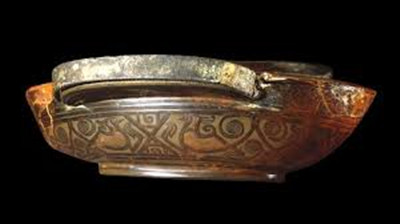Looking at the cup again, I can see that around the oval base runs a thin band with 67 Chinese characters on it.Now in Europe you might expect this kind of band to be a motto or a dedication, or something like that, but in fact here the characters list six craftsmen involved in the different processes involved in manufacturing the cup-making the wooden core, undercoat lacquering, top-coat lacquering, gilding the ear handles, painting, and then final polishing-the name of every one of the craftsmen.And then-and this could surely happen only in China-it goes on to list the seven product inspectors, whose responsibility was to guarantee quality.Six craftsmen, seven supervisors-this is the stuff of real bureaucracy.The list reads:
在耳杯的橢圓形底部有一圈共六十七個漢字。在歐洲,這里通常會是一句箴言或一條獻詞。但實際這里寫的卻是負責生產的六位不同種類的工匠的名字。制作木胎的,刷底層漆的,刷表層漆的,為把手鍍金的,描畫圖案的和最后打磨的。接下來列出了七位質量監督員的名字:這種情況恐怕只有在中國才會出現。六位工匠,七位監督人員,是官方組織運作的明證。這些字是:
"The wooden core by Yi, lacquering by Li, top-coat lacquering by Dang, gilding of the ear- handles by Gu, painting by Ding, final polishing by Feng, product inspection by Ping, supervisor-foreman Zong.In charge were Government Head Supervisor Zhang, Chief Administrator Liang, his deputy Feng, their subordinate Executive Officer Long, and Chief Clerk Bao."
素工矣、髹工立、上工當、銅耳黃涂工古、畫工定、玥工豐, 清工平、造工宗造,護工卒史章、長良、丞鳳、椽隆、令史褒主。
What I find fascinating about this cup, is that it is such a powerful document of the link between craft production and state administration; bureaucracy as a guarantee of beauty.It's not something that's familiar to the modern European, but for the journalist and China expert Isabel Hilton, it's a continuing tradition in Chinese history:
漆杯是工匠生產與官府管理相結合的產物。官僚系統保證了產品的品質。現代歐洲人也許對此并不熟悉,但作家兼中國專家伊莎貝爾希爾頓則認出這是中國的傳統:
"Well in Han times, the government had a major role in industry, partly to deal with its military expenditure in order to finance the kind of expeditions that it required against the aggressive peoples of the north and the west, again echoes of today.
漢朝時,朝廷大量參與工業制作,目的之一便是籌措軍費,征討西方與北方的蠻夷。












